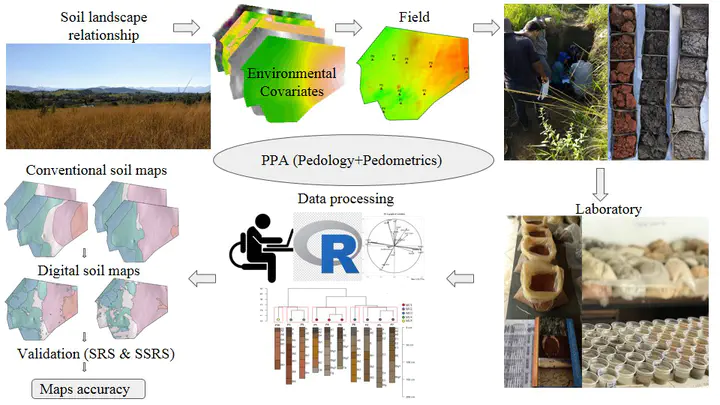Training pedologist for soil mapping-Contextualizing methods and its accuracy using the project pedagogy approach
 Image credit: Elias
Image credit: Elias
Resumo
There is a growing demand for more detailed knowledge about soils, their functions, and connections with human activities and environmental services. In Brazil, where soil survey and mapping have been scarce since the 1990s, there is a remarkable sense of urgency. Recently, a national soil program was created (PronaSolos) to attend to the massive demand for soil information. PronaSolos is an effort to return to the systematic soil mapping of the national territory, which requires many pedologists who master the traditional knowledge of soil mapping, but above all, the modern and accurate digital soil mapping (DSM) techniques. Based on these aspects, this study aims to address the technical and educational aspects inherent in the training process of new pedologists by contextualizing different soil mapping methods using the pedagogy project approach (PPA). Specifically, the study sought to assess the following subjects- (i) evaluate the learning process of different apprentices in performing soil survey and mapping in a small training area; (ii) compare maps generated by conventional soil mapping (CSM) and DSM using two probabilistic design for validation (SRS -Simple Random Sampling and SSRS - Stratified Simple Random Sampling). The DSM techniques evaluated were- Multinomial Logistic Regression - MLR and Random Forest - RF. For the course, four apprentices were selected and trained in both CSM and DSM techniques. Finally, they were asked about the learning process in the PPA and improvement for future courses. This study showed that- a) the PPA is promising to train new pedologists since, by mixing theoretical activities and contextualized practices (a project in progress), it not only awakens great motivation and critical capacity but also develops the ability for apprentices to find solutions in a area in constant evolution; b) the quality of the maps changed significantly according to the validation sample design applied. The CSM present better quality than DSM, mainly when using SSRS. The RF presented equivalent accuracy to CSM using SRS. Irrespective to validation sample design, the MLR presented the lowest accuracy; c) The CSMs presented higher user’s accuracy while the DSMs presented higher producer’s accuracy; d) The quality of CSM generated by the apprentices was not clearly related to the previous experience and knowledge in soil science.
Supplementary notes can be added here, including code, math, and images.